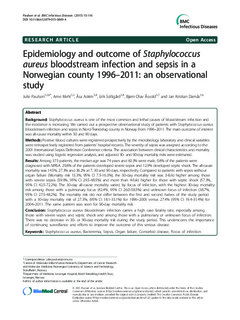| dc.contributor.author | Paulsen, Julie | |
| dc.contributor.author | Mehl, Arne | |
| dc.contributor.author | Askim, Åsa Susanne | |
| dc.contributor.author | Solligård, Erik | |
| dc.contributor.author | Åsvold, Bjørn Olav | |
| dc.contributor.author | Damås, Jan Kristian | |
| dc.date.accessioned | 2015-05-03T20:58:18Z | |
| dc.date.accessioned | 2015-12-14T14:50:49Z | |
| dc.date.available | 2015-05-03T20:58:18Z | |
| dc.date.available | 2015-12-14T14:50:49Z | |
| dc.date.issued | 2015 | |
| dc.identifier.citation | BMC Infectious Diseases 2015 | nb_NO |
| dc.identifier.issn | 1471-2334 | |
| dc.identifier.uri | http://hdl.handle.net/11250/2367691 | |
| dc.description.abstract | Background:
Staphylococcus aureus is one of the most common and lethal causes of bloodstream infection and the incidence is increasing. We carried out a prospective observational study of patients with Staphylococcus aureus bloodstream infection and sepsis in Nord-Trøndelag county in Norway from 1996–2011. The main outcome of interest was all-cause mortality within 30 and 90 days.
Methods:
Positive blood cultures were registered prospectively by the microbiology laboratory and clinical variables were retrospectively registered from patients’ hospital records. The severity of sepsis was assigned according to the 2001 International Sepsis Definition Conference criteria. The association between clinical characteristics and mortality was studied using logistic regression analysis, and adjusted 30- and 90-day mortality risks were estimated.
Results:
Among 373 patients, the median age was 74 years and 60.3% were male. 0.8% of the patients were diagnosed with MRSA. 29.8% of the patients developed severe sepsis and 12.9% developed septic shock. The all-cause mortality was 14.5%, 27.3% and 36.2% at 7, 30 and 90 days, respectively. Compared to patients with sepsis without organ failure (Mortality risk 13.3%, 95% CI 7.5-16.3%), the 30-day mortality risk was 3-fold higher among those with severe sepsis (39.9%, 95% CI 29.5-48.5%) and more than 4-fold higher for those with septic shock (57.3%, 95% CI 42.5-72.2%). The 30-day all-cause mortality varied by focus of infection, with the highest 30-day mortality risk among those with a pulmonary focus (42.4%, 95% CI 26.0-58.5%) and unknown focus of infection (38.7%, 95% CI 27.5-48.2%). The mortality risk did not differ between the first and second halves of the study period with a 30-day mortality risk of 27.3%, (95% CI 18.1-33.1%) for 1996–2003 versus 27.4% (95% CI 19.4-31.4%) for 2004–2011. The same pattern was seen for 90-day mortality risk.
Conclusion:
Staphylococcus aureus bloodstream infection carries a high case fatality rate, especially among those with severe sepsis and septic shock and among those with a pulmonary or unknown focus of infection. There was no decrease in 30- or 90-day mortality risk during the study period. This underscores the importance of continuing surveillance and efforts to improve the outcome of this serious disease. | nb_NO |
| dc.language.iso | eng | nb_NO |
| dc.publisher | BioMed Central | nb_NO |
| dc.title | Epidemiology and outcome of Staphylococcus aureusbloodstream infection and sepsis in a Norwegian county 1996–2011: an observational study | nb_NO |
| dc.type | Journal article | nb_NO |
| dc.type | Peer reviewed | en_GB |
| dc.date.updated | 2015-05-03T20:58:18Z | |
| dc.source.volume | 15 | nb_NO |
| dc.source.journal | BMC Infectious Diseases | nb_NO |
| dc.source.issue | 1 | nb_NO |
| dc.identifier.doi | 10.1186/s12879-015-0849-4 | |
| dc.identifier.cristin | 1240188 | |
| dc.description.localcode | © 2015 Paulsen et al.; licensee BioMed Central. This is an Open Access article distributed under the terms of the Creative Commons Attribution License (http://creativecommons.org/licenses/by/4.0), which permits unrestricted use, distribution, and reproduction in any medium, provided the original work is properly credited. The Creative Commons Public Domain Dedication waiver (http://creativecommons.org/publicdomain/zero/1.0/) applies to the data made available in this article, unless otherwise stated. | nb_NO |
